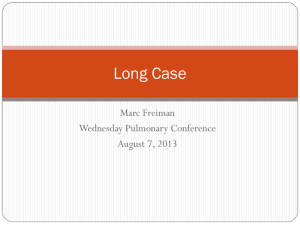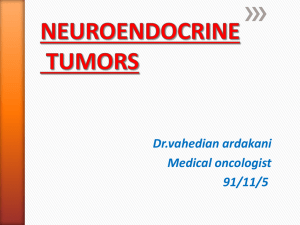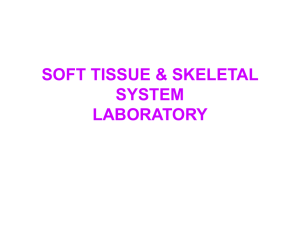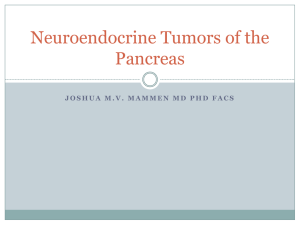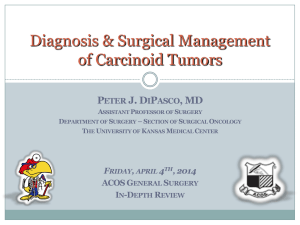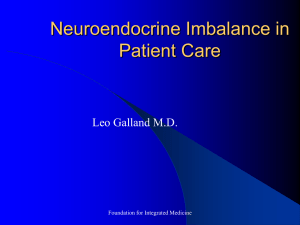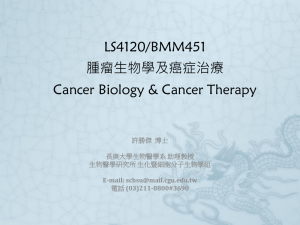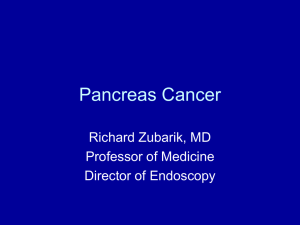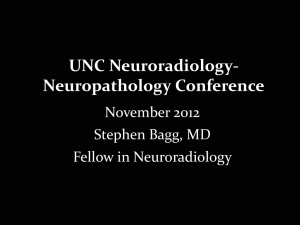Oversikt over medlemmer i ”NET-gruppen” 2012
advertisement
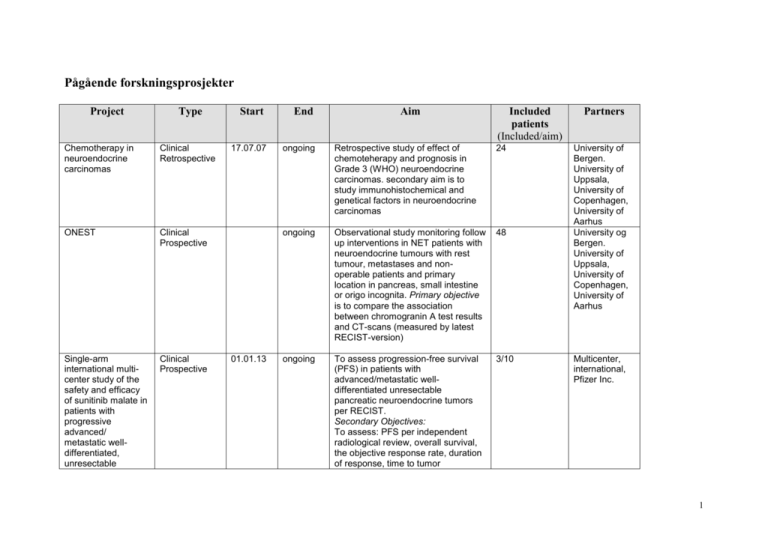
Pågående forskningsprosjekter Project Type Chemotherapy in neuroendocrine carcinomas Clinical Retrospective ONEST Clinical Prospective Single-arm international multicenter study of the safety and efficacy of sunitinib malate in patients with progressive advanced/ metastatic welldifferentiated, unresectable Clinical Prospective Start End 17.07.07 ongoing Retrospective study of effect of chemoteherapy and prognosis in Grade 3 (WHO) neuroendocrine carcinomas. secondary aim is to study immunohistochemical and genetical factors in neuroendocrine carcinomas 24 ongoing Observational study monitoring follow up interventions in NET patients with neuroendocrine tumours with rest tumour, metastases and nonoperable patients and primary location in pancreas, small intestine or origo incognita. Primary objective is to compare the association between chromogranin A test results and CT-scans (measured by latest RECIST-version) 48 ongoing To assess progression-free survival (PFS) in patients with advanced/metastatic welldifferentiated unresectable pancreatic neuroendocrine tumors per RECIST. Secondary Objectives: To assess: PFS per independent radiological review, overall survival, the objective response rate, duration of response, time to tumor 3/10 01.01.13 Aim Included patients (Included/aim) Partners University of Bergen. University of Uppsala, University of Copenhagen, University of Aarhus University og Bergen. University of Uppsala, University of Copenhagen, University of Aarhus Multicenter, international, Pfizer Inc. 1 pancreatic neuroendocrine tumors response.To evaluate: Choi criteria, Chromogranin A response, the safety and tolerability of sunitinib. To explore the potential relationship between plasma soluble KIT levels and measure the efficacy including PFS A European Multicenter Comparison of Laparoscopic and Open Distal Pancreatectomy for Pancreatic Neuroendocrine Tumors Clinical/ basal Prospective 01.11.13 01.08.14 To compare perioperative and oncologic outcomes of patients undergoing open distal pancreatectomy with laparoscopic distal pancreatectomy. 0/200 Correlation between genomic imbalances, cell proliferation and tumor size in sporadic pancreatic neuroendocrine tumors Basal 01.04.11 01.11.13 To increase knowledge about the genetic mechanisms underlying sporadic pancreatic neuroendocrine tumors 15/15 Department of Hepato-BiliaryPancreatic Surgery, Pole des maladies de l’appareil digestif, Hopital Beaujon, Assistance Publique– Hopitaux de Paris, Clichy, France; Department of General Surgery, Royal Infirmary of Edinburgh, Edinburgh, Scotland Section for Cancer Cytogenetics, Institute for Medical Informatics, The Norwegian Radium Hospital; 2 Centre for Cancer Biomedicine, University of Oslo Whole transcriptome sequencing of sporadic pancreatic tumors Basal 01.01.12 01.06.14 To detect fusion genes in sporadic pancreatic neuroendocrine tumors 13/13 Surgical treatment of pancreatic neuroendocrine carcinoma (WHO G3): a nordic multicenter casecontrol study Clinical Prospective 01.05.13 01.03.14 To define the role of surgery in the treatment of pancreatic NEC 120/120 Risk factors for sporadic pancreatic neuroendocrine tumors: a european multicenter casecontrol study – the Clinical Prospective 12 patients from Oslo 01.10.12 01.01.15 To determine risk factors for the development of sporadic pancreatic neuroendocrine tumors 65/250 30 patients from Oslo Section for Cancer Cytogenetics, Institute for Medical Informatics, The Norwegian Radium Hospital; Centre for Cancer Biomedicine, University of Oslo; Norwegian Sequencing Centre, Ullevål Hospital Nordic Neuroendocrin e Tumor Group (contributions from 12 Nordic University Hospitals) Pancreas 2000 Program (contributions from 5 European University 3 ePiNET Study Second cancer in patients with NET By the official figures of Cancer Norway evaluate the proportion of patients with NET that also get a second cancer diagnosed compared to the rest of the population To determine whether patients with serotonin producing ileal neuroendocrine tumors (SI-NETs, previously called carcinoids) develop skin fibrosis and hyperkeratosis secondary to chronic hyperserotinemia. Hospitals) Cancer Norway Epidemiology 15,04,12 ongoing Do patients with small intestinal neuroendocrine tumors (SI-NETs) develop hyperkeratosis and skin fibrosis secondary to chronic hyperserotoninemia? Epidemiological and prognostic factors for patients with neuroendocrine pancratic tumors Myocardial function by two dimensional speckle tracking echocardiography and Activin A may predict mortality in patients with carcinoid intestinal disease Basal 01.01.13 01.09.13 Epidemiology 01.08.11 01.09.13 To evaluate epidemiological and prognostic factors in patients with neuroendocrine pancratic tumors treated at our center. 114 Clinical/basal Prospective 01.01.11 30.08.13 To identify factors that influence mortality in patients with carcinoid intestinal disease, with special focus on biventricular cardiac involvement as assessed by estimating systolic function by 2D STE in the RV and the LV. To study the association of inflammatory and fibrinogenic biomarkers to mortality in these patients was also evaluated 92 Stress, social support, general self-efficacy and health related quality of life in patients with neuroendocrine tumors Clinical Prospective/ retrospective 01.08.05 01.06.13 To obtain increased understanding and knowledge concerning quality of life for patients with the rare cancer diagnosis neuroendocrine tumor (NET) and an educational program based on health promotion behaviors due to the multidisciplinary cognitive theory including the concept of self- 269 113 from Oslo Prospective part including 20 patients. 2/2 St.Olavs Hospital, Trondheim Norway University of Bergen 4 efficacy. Pancreatic surgery with vascular reconstruction in patients with locally advanced pancreatic neuroendocrine tumors Why do liver metastases from neuroendocrine small intestinal tumors grow so much faster than the primary tumor? Clinical Prospective 01.06.12 Basal Characterization and targeting of the neuroendocrine stem cell niche Symptoms, symptom 01.01013 To evaluate the feasibility and outcome of pancreatic resections with vascular reconstruction in patients with locally advanced PNET 7/7 2013 To compare gene-activation in tissue specimen from the primary tumor with tissue from liver and other metastases in the same patient to find genetic pathways that are activated in the metastases and not in the primary tumor to give new insight into the biological behavior of neuroendocrine tumors and could give potential new therapeutic targets. Secondary objective: Try to find genetic markers specific for neuroendocrine tumors that could be detected in blood samples. 0/15 Basal Winter 2014 0/5 -Yale School of Medicine, New Haven, USA, -St. Olavs Hospital, Trondheim Norway Clinical 2014 1) Examine the role of hypoxic stress in the development of the stem-cell phenotype and determine the NETstem cell hypoxic signature. 2) Determine critical regulators of hypoxia-mediated proliferation and metastasis in NET-stem cells. 3) Identify and collect “multipotential” cell populations from NETs and assess expression of hypoxiaassociated malignant signatures (proliferation and metastases) in clinical samples. To relate quality of life in patients 0/50 Haukeland 5 allieviation and quality of in patients with metastatic small intestinal neuroendocrin tumors Expletory noninterventional study for evaluating the diagnostic, prognostic and response-predictive value of a multimarker approach in metastatic midgut neuroendocrine tumors with metastatic small intestinal neuroendocrin umors and relate this to disease extent, progression and treatment Clinical Spring 2014 To describe the potential prognostic value of a multivariate analysis of 92 potential cancer biomarkers in patients with metastatic midgut NETs. Secondary objectives: To investigate a possible diagnostic value of a multivariate analysis of 92 potential cancer biomarkers in patients with metastatic midgut NETs. To investigate a possible response predictive value of a multivariate analysis of 92 potential cancer biomarkers in patients with metastatic midgut NETs.To investigate how the analysed biomarker levels respond to somatostatin analog treatment. To investigate how the analysed biomarker levels respond to other treatment modalities. University Hospital, bergen, Norway 0/15 Nordic multicenterfe 6
